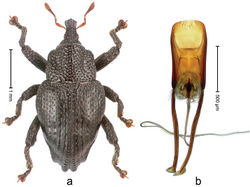Trigonopterus binodulus
| Notice: | This page is derived from the original publication listed below, whose author(s) should always be credited. Further contributors may edit and improve the content of this page and, consequently, need to be credited as well (see page history). Any assessment of factual correctness requires a careful review of the original article as well as of subsequent contributions.
If you are uncertain whether your planned contribution is correct or not, we suggest that you use the associated discussion page instead of editing the page directly. This page should be cited as follows (rationale):
Citation formats to copy and paste
BibTeX: @article{Riedel2014ZooKeys, RIS/ Endnote: TY - JOUR Wikipedia/ Citizendium: <ref name="Riedel2014ZooKeys">{{Citation See also the citation download page at the journal. |
Ordo: Coleoptera
Familia: Curculionidae
Genus: Trigonopterus
Name
Trigonopterus binodulus Riedel sp. n. – Wikispecies link – ZooBank link – Pensoft Profile
Diagnostic description
Holotype, male (Fig. 15a). Length 3.38 mm. Color of tarsi and antennae ferruginous, remainder black. Body elongate; in dorsal aspect with marked constriction between pronotum and elytron; in profile dorsally evenly convex. Rostrum with median carina terminating on forehead and pair of submedian ridges; intervening furrows each with row of erect piliform scales; epistome with transverse, angulate ridge forming median denticle. Pronotum anterolaterally subangularly projecting; with subapical constriction; disk coarsely punctate, interspaces dull, microreticulate; each puncture containing small seta; disk with pair of submedian, shallow impressions. Elytra with striae indistinct; intervals flat; punctation confused; each puncture containing small recumbent seta; interspaces dull, coriaceous, microreticulate; interval 7 swollen subapically, weakly projecting laterally; sutural interval at apex markedly swollen, forming pair of rounded apical protrusions. Anteroventral ridge of femora forming blunt tooth. Metafemur subapically with stridulatory patch and transverse row of denticles. Abdominal ventrite 5 with broad impression, sparsely setose with long erect setae. Penis (Fig. 15b) with sides of body subparallel; apex broadly rounded; transfer apparatus small, spiniform; apodemes 1.5 × as long as body; ductus ejaculatorius without bulbus. Intraspecific variation. Length 2.78–4.20 mm. Integument of males dull, coriaceous-microreticulate; females with interspaces between punctures polished. Female rostrum dorsally with glabrous median costa bordered by rows of punctures and sublateral pair of furrows; epistome simple. Female elytra with lateral contour in basal half evenly convex; intervals 2–3 subapically costate. Male elytra with lateral contour in basal half sinuate, concave at level of hind legs; intervals 2–3 subapically with indistinct ridge.
Material examined
Holotype (MZB): ARC0202 (EMBL # LM655424), West Java Prov., Ciamis, Mt. Sawal, Batu Cakra, sample 1, S07°14.920', E108°15.762', 990 m, 01-X-2005 (MZB). Paratypes (MZB, SMNK, ZSM): W-Java Prov., Ciamis: 13 exx, ARC0160, ARC0171, ARC0201 (EMBL # LM655423), ARC0203 (EMBL # LM655425), ARC0218 (EMBL # LM655440), same data as holotype; 2 exx, ARC2688 (EMBL # LM655946), ARC2689 (EMBL # LM655947), Pangandaran, sample 3, S07°43.070', E108°39.634', 156 m, 22-IV-2012.
Distribution
W-Java Prov. (Pangandaran, Mt. Sawal). Elevation: 156–990 m.
Etymology
This epithet is a combination of the Latin prefix bi- (two) and the noun nodulus (small swelling) and refers to the structure of the elytral apex.
Notes
Trigonopterus binodulus Riedel, sp. n. was coded as “Trigonopterus sp. 315”.
Original Description
- Riedel, A; Tänzler, R; Balke, M; Rahmadi, C; Suhardjono, Y; 2014: Ninety-eight new species of Trigonopterus weevils from Sundaland and the Lesser Sunda Islands ZooKeys, (467): 1-162. doi
Images
|
